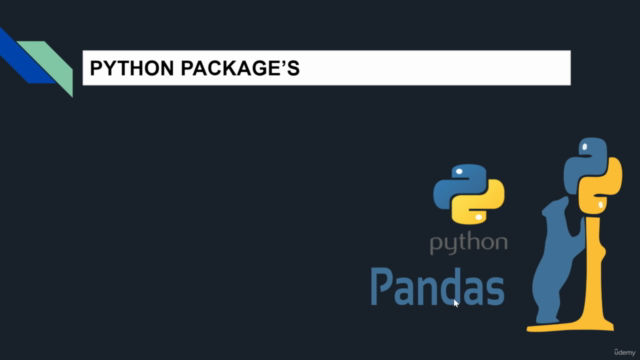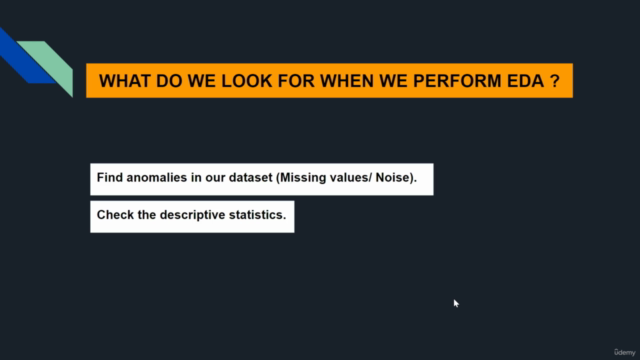EDA for Neurons

Why take this course?
🚀 Course Headline:
🎓 EDA for Neurons: Master Exploratory Data Analysis with Python, Pandas, Seaborn, Matplotlib & More!
Welcome to Your Journey in Data Science!
Are you eager to unlock the secrets of data and transform raw numbers into actionable insights? 🧐✨ Whether you're a complete beginner or looking to sharpen your data analysis skills, this course is designed to guide you through the intricacies of Exploratory Data Analysis (EDA) using Python, NumPy, Pandas, Seaborn, and Matplotlib.
What is Exploratory Data Analysis? 🤔
Exploratory Data Analysis (EDA) is a critical step in the data science workflow that involves examining datasets to find patterns, anomalies, or insights through summary statistics, visualization, and other data-summarizing techniques. EDA is essential for understanding your data before you begin any formal modeling or hypothesis testing.
- The Art of Discovery: EDA helps you discover underlying trends in data which can inform better decisions in your machine learning models and more. It's an exploratory phase where you analyze the data to understand its characteristics and formulate hypotheses.
- Data Visualization: Through visualization, you can effectively communicate insights with stakeholders and make informed decisions based on data patterns.
Why is EDA Crucial in Data Science? 🌟
EDA plays a pivotal role in the data science lifecycle:
- Error Identification: It helps identify obvious errors or inconsistencies in data sets.
- Pattern Recognition: It allows you to understand patterns within your data, spot outliers, and uncover interesting correlations.
- Decision Making: EDA ensures that the results are valid for any business outcomes you aim to achieve and helps stakeholders ask the right questions.
- Insightful Questions: EDA can answer important questions about data distributions, categorical variables, and confidence intervals.
Programming Language Used: Python 🐍
Python is a powerful tool in the data scientist's arsenal. Its simplicity, versatility, and robust ecosystem make it the go-to language for EDA. With its dynamic semantics and extensive libraries, Python excels at identifying missing values, handling large datasets, and enabling rapid development of applications.
Course Curriculum:
📚 Topics Covered:
- Python Programming Fundamentals: Lay the foundation for your data science journey with a solid grasp of Python.
- NumPy Mastery: Learn to create and manipulate arrays efficiently using NumPy, the fundamental package for numerical computation in Python.
- Data Manipulation with Pandas DataFrames: Get hands-on experience with one of the most powerful data manipulation libraries available.
- File Operations with Pandas: Master reading from and writing to various file formats using Pandas.
- Data Visualization with Matplotlib and Seaborn: Turn your data into compelling visual stories with these industry-standard libraries for data visualization.
- Exploratory Data Analysis on the Titanic Dataset: Apply your skills to a real-world dataset, gaining insights and uncovering hidden patterns.
- Advanced EDA Techniques: Dive deeper into statistical measures, transformations, and feature engineering.
- Portfolio Development: Build a portfolio of your Python data analysis skills to showcase to potential employers or clients.
- Real-World Project Experience: Work on projects that will give you practical experience in visualizing and interpreting real-world data.
By the End of This Course, You Will:
✍️ Understand Python: You'll have a grasp of how to program effectively in Python, which is crucial for any data science workflow. 📊 Master NumPy & Pandas: You'll be able to create and manipulate complex datasets with ease, using these libraries like a pro. 📈 Visualize Data with Matplotlib & Seaborn: Your visualizations will not only be functional but also visually appealing. 🧠 Perform EDA: You'll understand the importance of EDA and how to apply it to extract meaningful insights from data. 🛠️ Develop a Portfolio: Showcase your Python data analysis skills with a portfolio that demonstrates your capabilities to future employers or clients.
Join us on this enlightening journey into the world of data science, where you'll turn raw data into actionable insights! 📊💡🚀
Course Gallery




Loading charts...